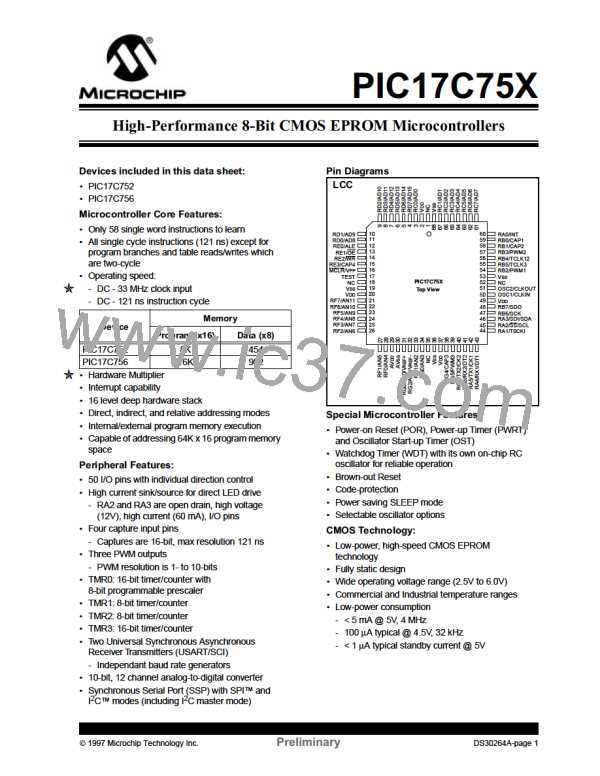PIC17C75X
11.3
Timer2 Overview
11.0 OVERVIEW OF TIMER
RESOURCES
The PIC17C75X has four timer modules. Each module
can generate an interrupt to indicate that an event has
occurred. These timers are called:
The Timer2 module is an 8-bit timer/counter with an
8-bit period register (PR2). When the TMR2 value rolls
over from the period match value to 0h, the TMR2IF
flag is set, and an interrupt will be generated if
enabled. In counter mode, the clock comes from the
RB4/TCLK12 pin, which can also provide the clock for
the Timer1 module.
• Timer0 - 16-bit timer with programmable 8-bit
prescaler
• Timer1 - 8-bit timer
TMR2 can be concatenated with TMR1 to form a
16-bit timer. The TMR2 register is the MSB and TMR1
is the LSB. When in the 16-bit timer mode, there is a
corresponding 16-bit period register (PR2:PR1). When
the TMR2:TMR1 value rolls over from the period
match value to 0h, the TMR1IF flag is set, and an
interrupt will be generated if enabled.
• Timer2 - 8-bit timer
• Timer3 - 16-bit timer
For enhanced time-base functionality, four input Cap-
tures and three Pulse Width Modulation (PWM) out-
puts are possible. The PWMs use the Timer1 and
Timer2 resources and the input Captures use the
Timer3 resource.
11.4
Timer3 Overview
11.1
Timer0 Overview
The Timer3 module is a 16-bit timer/counter with a
16-bit period register. When the TMR3H:TMR3L value
rolls over to 0h, the TMR3IF bit is set and an interrupt
will be generated if enabled. In counter mode, the
clock comes from the RB5/TCLK3 pin.
The Timer0 module is a simple 16-bit overflow counter.
The clock source can be either the internal system
clock (Fosc/4) or an external clock.
When Timer0 uses an external clock source, it has the
flexibility to allow user selection of the incrementing
edge, rising or falling.
When operating in the four capture mode, the period
registers become the second (of four) 16-bit capture
registers.
The Timer0 module also has a programmable pres-
caler. The PS3:PS0 bits (T0STA<4:1>) determine the
prescale value. TMR0 can increment at the following
rates: 1:1, 1:2, 1:4, 1:8, 1:16, 1:32, 1:64, 1:128, 1:256.
11.5
Role of the Timer/Counters
The timer modules are general purpose, but have ded-
icated resources associated with them. TImer1 and
Timer2 are the time-bases for the three Pulse Width
Modulation (PWM) outputs, while Timer3 is the
time-base for the four input captures.
Synchronization of the external clock occurs after the
prescaler. When the prescaler is used, the external
clock frequency may be higher then the device’s fre-
quency. The maximum external frequency, on the
T0CKI pin, is 50 MHz, given the high and low time
requirements of the clock.
11.2
Timer1 Overview
The Timer1 module is an 8-bit timer/counter with an
8-bit period register (PR1). When the TMR1 value rolls
over from the period match value to 0h, the TMR1IF
flag is set, and an interrupt will be generated if
enabled. In counter mode, the clock comes from the
RB4/TCLK12 pin, which can also be selected to be the
clock for the Timer2 module.
TMR1 can be concatenated with TMR2 to form a
16-bit timer. The TMR1 register is the LSB and TMR2
is the MSB. When in the 16-bit timer mode, there is a
corresponding 16-bit period register (PR2:PR1). When
the TMR2:TMR1 value rolls over from the period
match value to 0h, the TMR1IF flag is set, and an
interrupt will be generated if enabled.
1997 Microchip Technology Inc.
Preliminary
DS30264A-page 85

 MICROCHIP [ MICROCHIP ]
MICROCHIP [ MICROCHIP ]